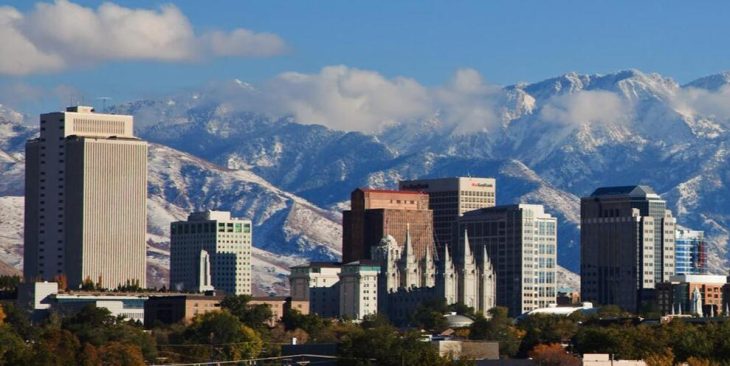Abbreviated as NH, New Hampshire is one of the thirteen states of New England, which formed the nucleus of the current North American Confederation, today the 44th in decreasing order of surface area (24,195 sq km), the 43rd by absolute population (465,293 residents, According to the 1930 census), but the 24th for population density (19.2 inhabitants per sq. km.). The territory of the state forms a triangle with a base (border with Massachusetts) between the Atlantic and Connecticut, whose upper and median course divides it (to the west) from Vermont; the other side is the straight border with Maine, which follows the 71 ° long. O. The northern summit touches the Canadian border; the maximum width of the triangle does not reach 150 km., the length exceeds 275: thus the state extends from the ridge of the White Mountains – where M. Washington rises up to 1914 m., the highest point in the United States east of the Mississippi – to the Atlantic shore, of which the short flap around Portsmouth. Overall, it is a hilly area with soft undulations, except in New Hampshire, where the effects of the Pleistocene glaciation are added to the more decisive relief of the White Mountains, visible above all in the large number (about 600) of small and medium lakes, as a rule elongated in the sense of the valleys, which decline regularly from north to south This mountain area partly retains the original woodland mantle, which in S. del Lago Winnepesaukee has given way to crops. The climate is harsh (average January temperature −6 °,
Only 9% of the surface of the state is cultivated (the prevalence of the rocky soil is underlined by the nickname that the Americans give to New Hampshire: the Granite State); for 60% it is wood; for the rest of the grasslands and unproductive (lake or stagnant waters). Cereal production is therefore scarce (wheat, potatoes, oats); a certain importance has instead the fruit (especially the pometo). The breeding allows a profit even higher than that of agriculture (131 thousand head of cattle), but always within rather modest limits (16.7 million dollars in 1931). The riches of the subsoil are few and not very noteworthy.
On the other hand, industrial development is very active: 1065 enterprises with 65 thousand workers in 1929. The textile industries (888 thousand looms, with a consumption of 122 thousand bales of cotton in 1932), the shoe factory and the wood industries lead the way.. Today the equipment of the tourist industries is also noteworthy, attracting an increasing number of visitors to the lakes area.
The state had 142,000 residents in 1790; 285,000 in 1850 and 412,000 in 1900. Its growth was rather slow: 4.6% from 1900 to 1910 (430,572 residents), 2.9% from 1910 to 1920 (443,083 residents), 5 % in the last decade. Those born abroad represented 17.8% of the total population in 1930. Of these, the majority (61.7%) are Canadians (50,959 in 1930), 5,817 Irish, 4,101 Poles, 3922 British, 3,233 Greeks; the Italians were in 1930 in number of 1938. The Negroes represent just 0.2% of the total. The urban population slightly exceeded the rural in 1900 (55%); since then it has risen to 61.3% in 1920, to drop to 58.7% in the last census. No inhabited center touches 100 thousand inhabitants; Manchester had 76,834 in 1930. The capital, Concord, is a small town of 25,228 residents.
History
The territory that today constitutes the state was part of the territory granted by James I to the Council of New England in 1620. This council made between 1622-35 a dozen donations of these lands to John Mason, Sir Ferdinando Gorges and several others private individuals and moral entities, in order to create a tangle of contradictory rights, which dragged on in disputes and trials until the end of the 18th century. In 1642, on its own initiative, New Hampshire was annexed to Massachusetts, as an integral part of the colony, but in 1679, following a quarrel between the Mason’s heirs and Massachusetts over its northern frontier, New Hampshire was established. as an independent province, with a president and council appointed by the king and an assembly elected by the people, but the crown reserved the right of veto. This was the first royal government established in New England. In 1684, under the governorship of Edward Cranfield, a creature of the Mason, New Hampshire was the scene of a serious religious struggle, but attempts to impose Anglicanism ended in violent riots and Cranfield had to withdraw in despair. From 1686 to 1689 New Hampshire belonged to the “Dominion” of New England; after the failure of this attempted unification, and a vain effort to establish a government of its own, New Hampshire joined Massachusetts, but in 1692 the Masons obtained the creation of a new royal government which lasted until the American Revolution. During the first half of the 18th century the two colonies were under the same governor, de facto this area. In 1741 the king intervened by granting New Hampshire even more than he had asked for. A conflict with New York over the western border lasted for many years (see vermont). The Mason’s heirs never managed to get the vast lands they claimed, but they caused serious turmoil in the life of the colony for many years. It also suffered much for the Indians. In 1768 New Hampshire supported Massachusetts in the question of “abrogation”, and during the revolution it hastened to take the side of the colonies by signaling itself in the Battle of Bennington of 1777, won by its troops. New Hampshire was the ninth state that ratified the federal statute on June 21, 1788, thus giving it the force of law. Until 1812 the federal party more or less dominated the political life of the state, but from 1816 the democratic party gained an increasing influence under the leadership of William Plumer, and with the union of the sects it was able in 1819 to abolish the financial support given to the Congregational Church until then. The Democrats prevailed in the state, until the Republican party emerged in 1846. Then, as in all the northern states of the Union, the Democrats split over the issue of slavery, thus allowing the Republicans to dominate almost unchallenged during the second half of the 19th century.



